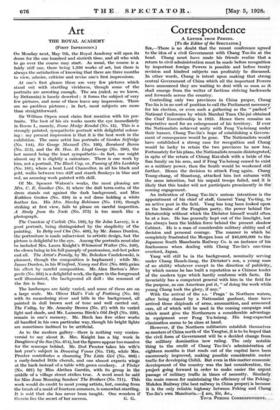Art
ON Monday next, May 7th, the Royal Academy will open its doors for the one hundred and sixtieth time, and all who wish to go over the course may start. As usual, the course is a fairly stiff one, there being 1,536 works of art, but there is always the satisfaction of knowing that there are three months to view, admire, criticise and revise one's first impressions.
At one's first glance there are very few pictures which stand out with startling vividness, though some of the portraits are arresting enough. The sea (ruled, as we know, by Britannia) is basely deserted ; it forms the subject of very few pictures, and none of these leave any impression. There are no problem pictures ; in fact, most subjects are more than straightforward.
Sir William Orpen must claim first mention with his por- traits. The best of his six works meets the eye immediately
in Room I., namely, Dame Madge Kendal (No. 15). This is a
strongly painted, sympathetic portrait with delightful colour- ing : my present impression is that it is the best work in the
exhibition. The same artist has portraits of Gordon Selfridge (No. 144), Sir George Maxwell (No. 193), Bernhard Baron (No. 215), and the Rt. Hon. D. Lloyd George (No. 290), the
last named being the least sympathetic—in fact, one might
almost say it is slightly a caricature. There is one work by him, not a portrait, The Black Cap, or, Passing of His Lordship
(No. 161), where a bent Lord Chancellor, in all his black and gold, walks between two stiff and starch flunkeys in blue and red, an amusing work painted with skill.
Of Mr. Spencer Watson's works, the most pleasing are Mrs. C. E. Gunther (No. 3) where the dull terra-cotta of the
dress stands out against the dark background, and Miss
Kathleen Gretton (No. 310) in a red dress holding a white feather fan. His Mrs. Stanley Robinson (No. 119), though striking at first view, fails to please on careful inspection. A Study from the Nude (No. 575) is too much hIce a photograph.
The Countess of Carlisk (No. 189), by Sir John LaverY, is a good portrait, being distinguished by the simplicity of the painting. In Betty and Chu (No. 409), by Mr. James Durden, the portraiture is made subservient to artistic design, but the picture is delightful to the eye. Among the portraits must also - be included Mrs. Laura Knight's Whimsical Walker (No. 348), the clown being in his full panoply of pantomime, red-hot poker- and all. The Artist's Pantily, by Mr. Boleslaw tzedekOwski, is pleasant, though the composition is haphazard ; while Mr.
James Durden, in his Winifred, Nancy and Eric (No.'693) gains his effect by careful composition. Mr. Alan Beeton's Mar- garlic (No. 262) is a delightful work, the figure in the foreground well illuminated, the backgrodnd all dull : the remnant of the fire is fine.
The landscapes are fairly varied, and some of them are on a large scale. Mr. Oliver Hall's Vale of Festiniog (No. 88) with its meandering river and hills in the background, all painted in dull brown sort of tone and well carried out, The Valley, by Mr. Arnesby Brown (No. 27) with its varied light and shade, and Mr. Lamorna Birch's Old Drift (No. 229), remain in one's memory. Mr. Birch has five other works_ all handled in his own particular way, though his bright lights are sometimes inclined to be artificial.
As to the modern gallery—there is nothing very contro- versial to say about it. Mrs. Knight has a big work in Daughters of the Sea (No. 674), but the figures appear too massive for the seascape behind. Mr. Dod Procter takes his wife's last year's subject in Drowsing Venus (No. 716), while Mrs. Procter contributes a charming The Little Girl (No. 686) a curly-headed little cherub, and one almost expects wings at the back instead of a table with green crockery. A Tinker (No. 691) by Miss Alethea Garstin, with its group in the middle of a village street strikes true. A word must be said for Miss Joan Manning Sanders' The Brothers (No. 711), This
work would do credit to most young artists, but, coming from the brush of a maid of fourteen summers, is somewhat startling. It is said that she has never been taught. One wonders if
therein lies the secret of her success: G. G.








































 Previous page
Previous page